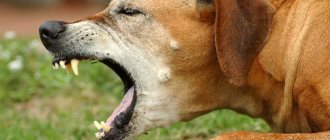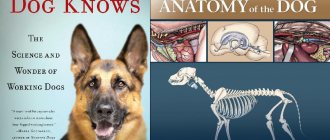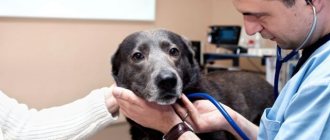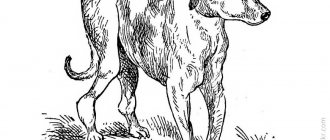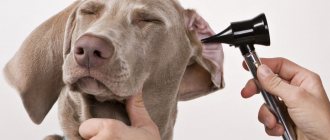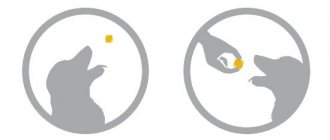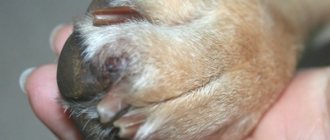The peak growth of animals occurs in the first months of their life. At this age, they require a very large amount of nutrients, including calcium, phosphorus and vitamin D - the main building materials of the musculoskeletal system. Their deficiency can lead to softening of the bones and bending of the limbs.
A similar situation is possible in adulthood, but is much less common. This pathology in puppies and dogs is called rickets, and its symptoms and treatment depend on the stage of development and timeliness of detection.
Description of the disease and its danger
The musculoskeletal system is the most important system of the body, responsible for ensuring motor actions, fixation and protection of internal organs. The bones and muscles of a newborn are very different from those of an adult. Up to about 1 year, they change their length and thickness, forming a more durable and easy-to-move structure.
Two elements play a major role in skeletal growth: calcium and phosphorus. Their absorption is ensured by vitamin D, or more precisely, two types of it: D2 and D3. The first enters the body from the outside along with plant foods, and the second is synthesized directly inside due to exposure to ultraviolet radiation.
REFERENCE!
Skeletal bones contain 99% and 85% of the total amount of calcium and phosphorus in the entire body, respectively.
If there is a deficiency of vitamin D, the animal develops an artificial deficiency of calcium and phosphorus. Because of this, bone tissue is deformed, softened and destroyed. The most obvious way to solve the problem is by increasing the amount of cottage cheese and fish in the diet, since the reasons are much deeper.
Necessary treatment
Signs of rickets can be easily noticed by any veterinarian at the first examination. Accordingly, the sooner you show your German Shepherd puppy to the doctor, the faster he will prescribe treatment. In this case, your pet has every chance to recover as much as possible.
One of the most effective ways to combat rickets, according to experts, is fish oil. It is necessary to apply fat every other day, one teaspoon at a time.
Also periodically feed your German Shepherd puppy foods high in vitamins A and D, such as:
- apples;
- carrot;
- liver;
- dairy products;
- milk;
- cottage cheese;
- cheese;
- vegetable oil;
- seafood;
- herbs.
Be sure to add phosphorus and calcium to your diet. With an optimal combination of these substances, the development of rickets can be prevented at any stage.
Never starve your dog. Throughout its life, the German Shepherd must adhere to a proper eating schedule, but always eat to its full.
For the treatment of rickets, long walks in the daytime in direct sunlight are ideal. These hikes can be replaced by artificial ultraviolet irradiation. The treatment is carried out under the supervision of a veterinarian; the dog is irradiated with ultraviolet light using quartz lamps for ten sessions. The first session is carried out for two minutes. By the tenth session, irradiation is increased to eight minutes.
Helminthiasis - infection with worms - can lead to complications of rickets, do not forget to get tested on time and get rid of worms.
You should check with your veterinarian for the names of other drugs that help in the fight against rickets.
Symptoms of rickets in dogs
The disorder diagnosed in adult animals is called osteomalacia. Despite the dissimilar name, the development mechanism and signs of this pathology and rickets in dogs are absolutely identical.
Thanks to a fairly clear clinical picture, even an inexperienced owner can recognize that something is wrong. The main symptoms of the disease include:
- lethargy and fatigue;
- curvature of the spine with a pronounced stoop or its downward bending (lordosis);
- loss of muscle tone (the pet moves on half-bent legs, and when you palpate them, severe flabbiness is felt);
- thickening (“bracelets”) of the joints on the hind limbs;
- nodular formations (“rosary beads”) on the anterior ends of the ribs, appearing due to uneven deposition of lime;
- curvature, crumbling or loss of teeth, as well as preservation of the milk row for too long;
- perverted appetite (eating feces, soil, dirt, wallpaper, filler);
- wide and noticeably sagging chest;
- deterioration in the quality of wool and skin;
- growth retardation;
- bending the paws inward (letter “X”) or outward (letter “O”).
Due to softening, the bones become very fragile. A sick pet can easily get injured due to a slight blow, a fall from a small height, or even a jump.
With a prolonged course, the pathology is complicated by spreading of the legs, pelvic collapse, lameness, convulsions and seizures. The animal loses the ability to move normally and becomes disabled.
Main symptoms
As long as the bitch feeds the puppies with breast milk, the problem does not appear, since the food contains all the necessary substances in ideal proportions. Rickets usually appears after the puppy begins to feed itself. If the food is chosen incorrectly, or other problems are added, the balance is disrupted and signs of rickets may appear:
- A sick puppy stands out in the litter for its small size; it is the weakest and smallest; stronger brothers and sisters often offend it and take away food.
- The dog has an unsociable or extremely affectionate, “sticky” disposition.
- Unlike its larger and stronger brothers, it gets tired quickly, can often sit down or lie down, its paws tremble, and its gait becomes uneven. Sometimes such animals suffer from convulsions and spasms due to weakness of muscles and bones.
- Typically, sick puppies have an excellent appetite, but after eating they may feel sick, have constipation or diarrhea, and the conditions can change each other regularly.
- With good nutrition, the dog's ribs and spine protrude, and the limbs become weak and crooked. A characteristic sign of rickets is a large belly with general thinness and crooked legs.
- The animal's joints enlarge, and nodular formations appear on some bones (ribs). The joints are not just enlarged - their shape is changed.
- When moving, the owner may notice that the puppy places its paws strangely, as if turning them in or out. Sometimes it can be just one paw or even individual joints, for example, the metatarsal parts of the foot, toes.
- When examining your teeth, you need to pay attention to the condition of the enamel. In a healthy dog it is smooth, white and shiny. One of the signs of rickets is a change in the color and texture of the enamel - it can be grayish or yellowish, becoming dull, as if porous. There may also be deviations in the process of changing baby teeth to permanent ones.
The sooner the owner notices deviations in the puppy’s behavior and health, the sooner treatment can begin. Rickets is dangerous not only because of the dysfunction and condition of the skeleton. Deformation of the bones leads to the fact that the internal organs are displaced, and this has an extremely negative effect on the overall health and development of the dog.
Causes of the disease
The main cause of the disease is hypovitaminosis. This term refers to a painful condition characterized by a lack of vitamins. It develops under the influence of the following factors:
- Incorrect calcium to phosphorus ratio due to poor feeding. Normally it should be 1.5:1 or 2:1.
- Lack of vitamins D. In this case, as mentioned above, the deficiency of calcium and phosphorus is artificial. In fact, there are enough of them, but they are not absorbed and are washed out.
- Imbalance of BJU. Both deficits and surpluses are dangerous for the body. They lead to metabolic failure and impair the quality of absorption of other elements.
- Insufficient amount of sunlight. Vitamin D is synthesized by ultraviolet rays. When kept in a closed enclosure or with little sun due to climatic conditions (St. Petersburg, Murmansk, London), the animal receives it only from food.
- Infections (distemper) and inflammation (bronchitis) that have a detrimental effect on metabolism.
- Artificial feeding. Not all bitch milk substitutes are created equal. There is too little vitamin D in goat and cow milk, and in artificial milk it all depends on the manufacturer.
The risk group includes puppies. They get sick much more often and more severely than adults, but, in addition to age, it is important to take into account several more points: poor nutrition, improper living conditions and the breed of the animal. Particular attention should be paid to large quadrupeds, which are characterized by very rapid growth in childhood.
REFERENCE:
With a prolonged course, hypovitaminosis is complicated by vitamin deficiency - a more severe pathological condition leading to a sharp deterioration in health.
Development factors
There are several probable causes that can cause the development of rickets in puppies. These include factors such as:
- keeping the puppy in dark and damp rooms without sunlight,
- unbalanced basic diet,
- genetic predisposition,
- gastrointestinal disorders.
Currently, the main cause is considered to be the inability to absorb vitamin D or its lack in food. Disturbances in biosynthesis processes in the liver, subcutaneous tissue, as well as pathology of the parathyroid glands are recognized as predisposing factors.
Danger, complications and consequences of rickets in puppies
The consequences of rickets in dogs can only be avoided at an early stage. Thanks to timely treatment, crooked paws and incorrect posture can be effectively corrected, as well as weakened muscles can be strengthened.
With a later diagnosis, the sick animal will face the following complications:
- convulsions and tremors after long walks;
- pain in the limbs when jumping and running;
- constant shortness of breath and painful breathing due to seals on the ribs;
- visually noticeable deformation of the chest and hip joint;
- various complications during pregnancy and childbirth;
- lack of teeth or severe malocclusion;
- concomitant pathologies of the heart, liver and kidneys.
To avoid death or disability of the dog, it should be shown to a veterinarian immediately after the first alarming symptoms are detected. The earlier treatment is started, the greater the likelihood of a positive prognosis.
Diagnosis and confirmation
To make a diagnosis, you must provide the doctor with detailed information about the maintenance and care of your pet. After studying the current diet and frequency of exposure to sunlight, the four-legged patient will undergo a full external examination.
The most revealing tests are blood tests and x-rays. Based on their results, it is possible to determine calcium and phosphorus deficiency, inflammatory processes and various internal disorders (destruction of the bone structure and the presence of thickenings).
How is rickets treated in puppies and adult dogs?
If during the diagnosis, in addition to rickets, an infection or inflammation was identified, then drug therapy is used to eliminate them. Most often it involves taking the following medications:
- antibiotics that fight bacteria;
- antiviral, destroying viruses;
- glucocorticosteroids that suppress the inflammatory process;
- anticonvulsants, stopping muscle cramps;
- probiotics that normalize intestinal microflora after antibiotics.
In the absence of concomitant diseases, treatment is based on adjusting the existing diet and increasing the amount of natural and artificial ultraviolet radiation. Depending on the severity of the disease, the animal is treated directly at home or in a hospital:
- Advanced stage.
The puppy is given intravenous vitamin drips and physiotherapeutic procedures with a quartz lamp are prescribed. In cases of cardiac dysfunction and acute digestive disorders, preparations with magnesium, enveloping and enzymatic agents are used.
- Initial stage.
In the absence of dangerous complications or immediately after normalization of the condition in the hospital, home treatment begins. It includes a mandatory diet, regular therapeutic massage, careful training to normalize physical activity and mandatory sunbathing in the morning.
If the lack of vitamin D is due to a poor diet, then to normalize it, fermented milk products, egg yolks, beef liver and sea fish are added to the daily menu. Based on the identified deficiencies, the sick four-legged animal is also prescribed a course of various vitamin and mineral complexes.
Prevention of rickets
A woman should take care of prevention during pregnancy.
Required:
- Balanced diet.
- Sufficient insolation (stay in the air).
- Maintaining a daily routine.
- Observation in consultation.
- Taking vitamin D from 32 weeks.
Prevention of rickets includes:
- Breastfeeding or adapted formulas.
- Timely introduction of complementary foods.
- Regular walks.
- Massage, gymnastics.
- Specific prevention (taking vitamin D).
To diagnose and treat rickets, as well as to receive detailed advice, contact experienced medical pediatricians




